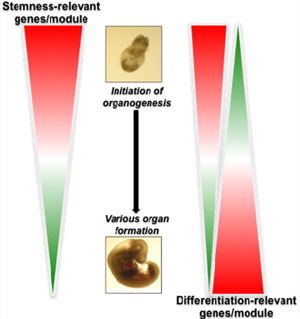人胚胎早期器官形成过程的转录组研究新进展
| 来源:生物谷 |
|
2010年7月,Developmental Cell杂志发表了中科院上海生命科学研究院/上海交大医学院健康科学研究所干细胞生物重点实验室金颖和张济课题组共同完成的研究论文。
着床后人胚胎发育涵盖了胚胎早期器官形成最关键时期,即从Carnegie Stage 9(胚胎发育第20天,E20)到Carnegie Stage 14(胚胎发育第32天,E32)。从发育形态变化角度,各个器官经历了从无到有的奇妙过程;从发育进化角度,这个奇妙过程高度保守;从发育潜能角度,干 性潜能与分化潜能既定时空程序协调性变化。这些背后的分子基础是遗传信息表达精密调控的基因相互作用网络。然而,相比模式生物与体外细胞模型研究,由于受 限于人胚胎研究标本以及伦理上的限制,关于人胚胎发育的分子机制知之甚少。 杨颖博士和方海博士等在金颖和张济导师的指导下,与新华医院妇产科合作,利用临床药物流产胚胎,应用基因芯片对 该早期器官胚胎发育6个连续阶段进行基因表达变化谱刻画。通过数据深层次挖掘并整合功能、转录调控、表型及疾病相关的数据库,他们发现整个胚胎形态变化受 基因表达谱变化所驱使,主要包括两组基因:呈现逐渐下调变化趋势的基因负责早期器官起始,而逐渐上调变化的基因主要参与器官原基形成。同小鼠发育表达谱以 及人胚胎干细胞各种组学数据进行比较分析,进一步发现干性相关基因呈逐渐降低的趋势,而分化相关基因呈现两种表达模式。 在此基础上,整合蛋白质相互作用信息,挖掘人胚胎早期器官过程中相互作用网络(hORGNet),由两个细化的与干性相关的模块 (hStemModule)和与分化相关的模块(hDiffModule)模块组成,分别表征干性潜能状态变化情况与分化状态。进一步通过小鼠表型富集分 析,hStemModule可能与胚胎早期致死相关,而hDiffModule则可能多的是与出生后致死相关。这一研究建立了国际上唯一的人早期器官形成 期基因表达的谱式,为探索人类发育早期的分子调控和人多能干细胞体外的定向诱导分化提供的宝贵的信息。 该研究工作得到国家自然科学基金、国家高技术研究与发展计划,上海市教育委员会重点学科建设项目和科学院创新项目等的支持。 原文出处: Developmental Cell, DOI:10.1016/j.devcel.2010.06.014 Transcriptome Analysis of Early Organogenesis in Human Embryos Genome-wide expression analysis of embryonic development provides information that is useful in a variety of contexts. Here, we report transcriptome profiles of human early embryos covering development during the first third of organogenesis. We identified two major categories of genes, displaying gradually reduced or gradually increased expression patterns across this developmental window. The decreasing group appeared to include stemness-specific and differentiation-specific genes important for the initiation of organogenesis, whereas the increasing group appeared to be largely differentiation related and indicative of diverse organ formation. Based on these findings, we devised a putative molecular network that may provide a framework for the regulation of early human organogenesis. Our results represent a significant step in characterization of early human embryogenesis and provide a resource for understanding human development and for stem cell engineering. |


